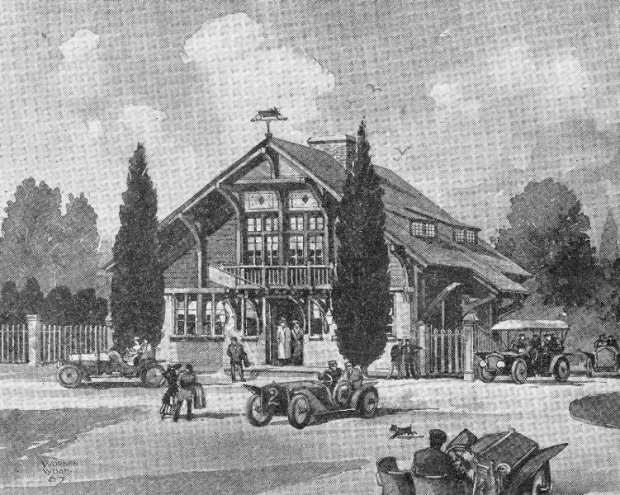The Motor Parkway Tollgate Inns That Were Never Built

In October 1906, William K. Vanderbilt Jr. and his associates announced "the first automobile speedway ever constructed in this or any other country".
As described in the October 25,1906 issue of The Automobile entitled "The Speedway Across Long Island", the plan called for "a straightaway road of 65 or more miles that will extend from Floral Park through the center of Long Island to Riverhead. The idea takes on a more practical phase than the mere building of a race course, the proposition being to provide an automobile highway..."
The article described the plan to have "inns" with tollgates allowing access at frequent intervals. "Each tollgate will take the form of an old English inn, where the motoring public will be privileged to refresh themselves under club conditions. Each inn will be provided with its garage, charging and supply station, oil-sprinkling equipment, road repairing tools and material."
Soon after the Motor Parkway plans were announced, architect John Russell Pope submitted this design for a tollgate inn. This plan was discovered in the archives at the Suffolk County Vanderbilt Museum.
As shown in Russell's design, the tollgate for the Motor Parkway was to the right of the inn.
Pope envisioned the first floor would have a waiting room, living room, kitchen and a keeper's door to collect tolls.
The second floor had three bedrooms, storage and a bathroom
The design called for a car weathervane on the roof of the inn. This feature was later incorporated into the Motor Parkway's general manager's office.
Among the 572 recently discovered survey maps of the Motor Parkway, only this survey included a sketch of a "toll-gate inn". The "Babylon Lodge" was planned for Lee Avenue at Wheatley Heights near Wyandanch. Neither the inn or a lodge was built at this location.
As described in Al Velocci's book The Toll Lodges of the Long Island Motor Parkway, and Their Gatekeepers' Lives, the inn concept was soon dropped due to costs and concerns about antagonizing hotel owners and automobile service companies along the Motor Parkway route. Russell replaced the inn concept with the smaller lodge design as shown here in the Meadow Brook Lodge. Russell designed the first six Motor Parkway lodges which all had small living spaces for the lodgekeeper's families and some of the design features from his original inn plans.










Comments